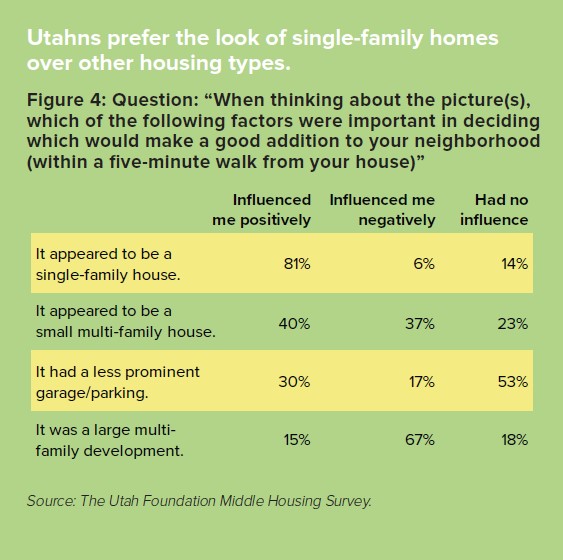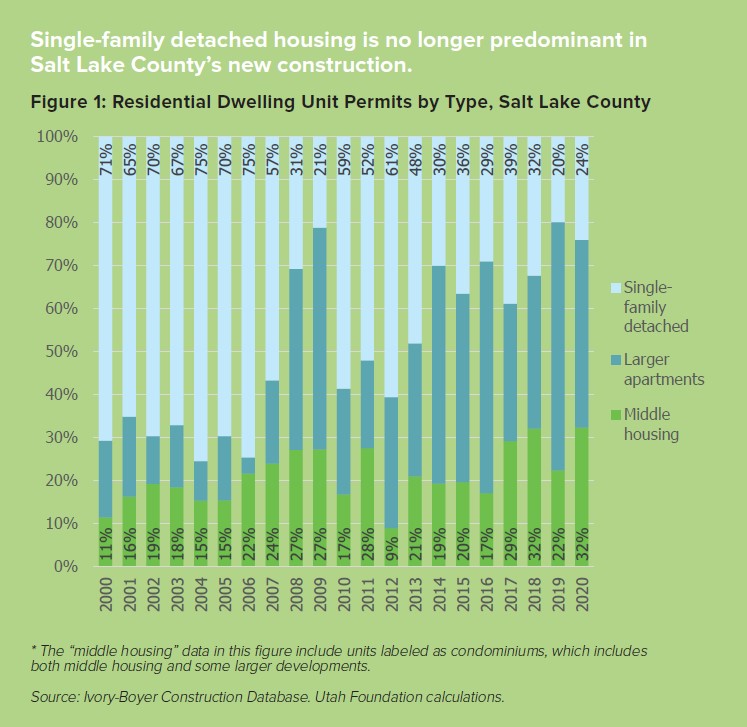MIDDLE HOUSING STUDY
Check out the other sections of the Middle Housing Study. Links will become live as reports are published
“Missing Middle Housing” is a term that encompasses a variety of multi-unit housing buildings that are house-scale, facilitate neighborhood walkability, accommodate changing demographics and preferences, and are available to people with a range of incomes. Middle housing offers the potential to increase the supply of housing, but at a scale that is not objectionable to most neighbors and in a manner that can improve upon neighborhoods. There are obstacles to increasing this type of housing, though they are not insurmountable.
The guide is separated into four parts. This part draws on the findings of a recent Utah Foundation survey to reveal favored approaches for new housing.
The first installment, “The Scope of the Challenge,” examined Utah’s housing problem and was released in November 2021. The second, “What is the Middle, and Where is it?” examines the prevalence of middle housing in the four largest Utah counties and the relevant development trends; it was released in December 2021. One more installment is forthcoming. It will look at obstacles and opportunities to increase the availability of middle housing.
KEY FINDINGS OF THIS REPORT
- Housing development is changing; for example, in Salt Lake County, single-family detached development is becoming less common (24% of new units in 2020), while middle housing is on the increase (32%), and larger multifamily units are taking up the lion’s share of new development (44%).
- Utah Foundation survey respondents prefer single-family detached housing, but they offered positive responses to some small middle housing with the appearance of a single-family home.
- Utahns’ preference for the appearance of single-family homes suggests that middle housing will meet with greater acceptance if developed in a manner that mimics the style and scale of single-family dwellings.
- Nearly three-quarters (72%) of survey respondents say that style is the most important factor (other than housing type) in their housing preferences, followed by scale – or the size compared to other homes (64%). Topping the list for open-ended comments is having lower density (35%).
- Half of survey respondents prefer housing of similar prices (47%) and similar types (50%) in their neighborhoods, but not far behind are people who prefer housing with a variety of prices (36%) and a variety of types (42%) – which includes middle housing.
- Most survey respondents (60%) support more affordable housing options in their neighborhoods, with 38% strongly supporting more options. About 18% of respondents oppose more affordable housing options, while 22% are neutral.
- To address affordability issues, about 46% of survey respondents would accept middle housing in their neighborhoods; 33% of respondents oppose middle housing, and the remainder are neutral.
- Expanding homeownership opportunities is an important component to any development strategy focused on middle housing. Homeownership is correlated with wealth; the median homeowner net worth is $255,000, while the median renter net worth is $6,300. However, in 2020, the share of renters priced out of Utah’s median-priced home jumped to 73%, from 63% the year before.
Read the full report: Is the Middle Missing? A Guide to Expanding Options for Utah Homebuyers and Renters – Utahns’ Development Preferences
Special thanks to Salt Lake County, the Sorenson Legacy Foundation, the Utah League of Cities and Towns, the Wasatch Front Regional Council and Y2 Analytics for providing project-based support.



